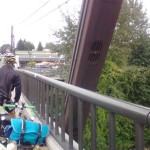WHAT IS THE SAFETY STOP?
The “Safety Stop” law that went into effect on Oct. 1 allows people on bicycles to treat stop signs as yield signs, allowing them to roll through an intersection if the coast is clear. The new law was lobbied for by Washington Bikes. Read our news release.
The Safety Stop is a simple, intuitive law that gives people bicycling the right to safely yield at a stop sign-controlled intersection. This is sometimes described as a rolling stop.
Complete stops are still required when approaching a stop sign on a school bus, and for stop signs located at railroad crossings.
BENEFITS OF THE SAFETY STOP
The Safety Stop allows a person bicycling to get ahead of motor vehicles behind them, creating space and diminishing the likelihood of collisions. Additionally, people riding bikes typically wait on the right side of the road near the stop sign. This is a frequent blind spot for people driving, leaving the person bicycling vulnerable and at risk, especially for drivers making right turns.
The Safety Stop encourages the use of streets regulated by stop signs, which are typically calmer and move at slower speeds. This lessens the amount of time people bicycling spend on busy, fast-paced streets, and also lessens the amount of time that bicyclists are exposed to risks in intersections, where the majority of serious crashes occur.
The Safety Stop legalizes typical riding behavior. People on bikes have no blind spots, unlike people in cars, and they can easily see if the coast is clear, which is why it is safe and intuitive for people on bikes to roll through intersections.
When a person on a bike stops, it takes multiple pedal revolutions to get back up to speed, which lengthens the time that a person riding remains in the danger zone. Stopping also slows down automobile traffic behind the bike rider. The Safety Stop allows a person bicycling to clear the intersection faster, enabling them to get ahead of motor vehicles behind them. This creates a smoother traffic flow.
The Safety Stop is not only safer, it is more user-friendly for people riding bikes and for people driving cars.
WHAT DOES THE DATA SHOW?
Washington is the fifth state, along with a number of municipalities, that have passed a Safety Stop law, improving safety and bicycle usability:
- Idaho passed a Safety Stop law, called the Idaho Stop, in 1982. The year following enactment of the law bicycling injuries declined by 14.5%. Since then there have been no negative safety impacts documented.
- Delaware passed a Safety Stop law in 2017, and in the 30 months since the law passed personal injury crashes involving bicycles fell by more than 20% compared to the previous 30 months.
- Arkansas, Delaware, Oregon and a number of municipalities in Colorado have followed Idaho in passing similar laws.



